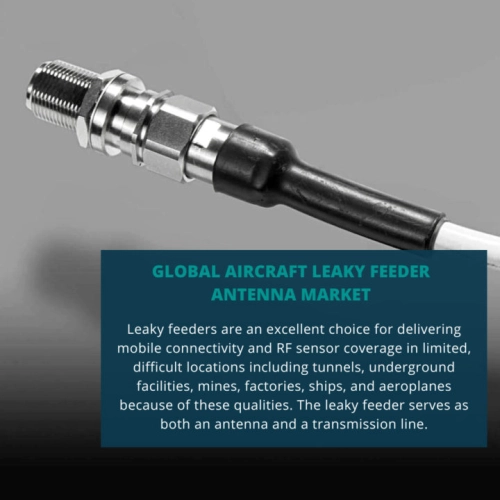
- Get in Touch with Us

Last Updated: Apr 26, 2025 | Study Period:
The outer conductor of the leaky feeder antenna, which is a modification of the common coaxial cable, is slit or pierced, allowing the cable to radiate. Leaky feeders are built of cables and are strong, adaptable, and resistant to the elements.

Leaky feeders are an excellent choice for delivering mobile connectivity and RF sensor coverage in limited, difficult locations including tunnels, underground facilities, mines, factories, ships, and aeroplanes because of these qualities. The leaky feeder serves as both an antenna and a transmission line.
The Global Aircraft leaky feeder antenna market accounted for $XX Billion in 2023 and is anticipated to reach $XX Billion by 2030, registering a CAGR of XX% from 2024 to 2030.
Signal propagation is improved with GORE Leaky Feeder Antennas, which may also result in less hardware being needed on the plane. These antennas deliver dependable connection to various wireless systems, such as access points for in-flight Wi-Fi and picocells for mobile phone coverage. Both wide-body and single-aisle passenger aircraft can use this.
A new, cutting-edge Ku-band antenna has been introduced by Panasonic Avionics Corporation (Panasonic Avionics), which was created in collaboration with ThinKom Solutions, Inc.
ThinKom's flight-tested VICTS (Variable Inclination Continuous Transverse Stub) technology is a foundational component of the newly developed ThinAir. Panasonic Avionics will make it available to its airline clients for both line-fit and retrofit installations.
It was revealed on June 7 by Redwire and MDA that they had each been awarded contracts to make 42 tactical communications antennas for American military satellites in low Earth orbit.
On satellites that will be a component of the Link 16 tactical data network, the antennae will be mounted. The U.S. military and NATO partners exchange data between ships, aircraft, and ground forces via the Link 16 standard.
| Sl no | Topic |
| 1 | Market Segmentation |
| 2 | Scope of the report |
| 3 | Abbreviations |
| 4 | Research Methodology |
| 5 | Executive Summary |
| 6 | Introduction |
| 7 | Insights from Industry stakeholders |
| 8 | Cost breakdown of Product by sub-components and average profit margin |
| 9 | Disruptive innovation in the Industry |
| 10 | Technology trends in the Industry |
| 11 | Consumer trends in the industry |
| 12 | Recent Production Milestones |
| 13 | Component Manufacturing in US, EU and China |
| 14 | COVID-19 impact on overall market |
| 15 | COVID-19 impact on Production of components |
| 16 | COVID-19 impact on Point of sale |
| 17 | Market Segmentation, Dynamics and Forecast by Geography, 2022-2030 |
| 18 | Market Segmentation, Dynamics and Forecast by Product Type, 2022-2030 |
| 19 | Market Segmentation, Dynamics and Forecast by Application, 2022-2030 |
| 20 | Market Segmentation, Dynamics and Forecast by End use, 2022-2030 |
| 21 | Product installation rate by OEM, 2022 |
| 22 | Incline/Decline in Average B-2-B selling price in past 5 years |
| 23 | Competition from substitute products |
| 24 | Gross margin and average profitability of suppliers |
| 25 | New product development in past 12 months |
| 26 | M&A in past 12 months |
| 27 | Growth strategy of leading players |
| 28 | Market share of vendors, 2022 |
| 29 | Company Profiles |
| 30 | Unmet needs and opportunity for new suppliers |
| 31 | Conclusion |
| 32 | Appendix |